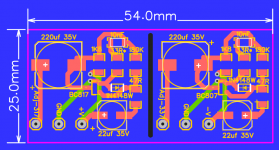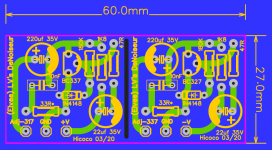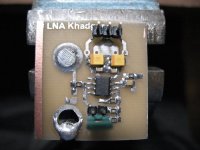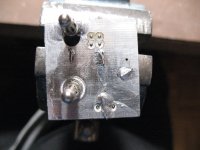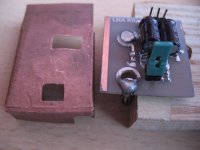If you add a denoiser just because of the DC/DC, no: at 300kHz, it does essentially nothing.Great work ! Elvee, I'm just wondering if the Denoiser is good apply to a LM317 based reg. that is powered by a DC to DC converter running around 300khz ? Of course, LC filter before the reg. is already there.
Passive measures like your LC are much more effective.
The denoiser is good at removing AF noise, 100/120Hz ripple and lowering the output impedance, but at 300kHz you cannot count on cheap active circuits like a 317 or a denoiser
YEAH!! Thanks!! Post the gerber files and I'll be the guinea.Smaller TH
Perhaps...Hicoco, if you don't have the gerber files for the smaller (60 x 27mm) retrofit denoiser PC, perhaps we can get Sadface to generate them?
I will order PCB and test it before any post
Excellent! Thanks again for your efforts!....I will order PCB and test it before any post
I received my Elvee/Sadface boards (for the whole LM317/337-with-denoiser circuit) from jlcpb today. Hooray! They appear to be very well-made. I will gather parts and assemble this week, and report back on their performance as best I can; I lack the ability to test for -100 db noise, however. But I can scope the output.
Last edited:
You can build some simple LNA like Elvee suggested to me some time ago, it will help you a bit to see what's going on even on oscilloscope with 5mV/div and if you have 2 or 1mV/div then you should really see what's going on. I builded this one some time ago and i even mentioned it in this topic. Pretty simple design, noise is around 24,5uV, in simulation it should be 21uV. I used OPA211 cause i had it at home, it's SMD so tracers can be really short, i made it x10 and x100 that is selectable with jumper. OPamp decoupling capacitors are 100n//10u//100u.
LNA is powered by 2x9V battery in separate box and there is 100uF decoupling in that box as well.
LNA is powered by 2x9V battery in separate box and there is 100uF decoupling in that box as well.
Attachments
Thanks for the tip! But...that's a $7 opamp! Do you think it would work OK with an LM4562?You can build some simple LNA like Elvee suggested to me some time ago, it will help you a bit to see what's going on..... I builded this one some time ago and i even mentioned it in this topic....... I used OPA211 cause i had it at home.
You can build some simple LNA like Elvee suggested to me some time ago, it will help you a bit to see what's going on even on oscilloscope with 5mV/div and if you have 2 or 1mV/div then you should really see what's going on. I builded this one some time ago and i even mentioned it in this topic. Pretty simple design, noise is around 24,5uV, in simulation it should be 21uV. I used OPA211 cause i had it at home, it's SMD so tracers can be really short, i made it x10 and x100 that is selectable with jumper. OPamp decoupling capacitors are 100n//10u//100u.
LNA is powered by 2x9V battery in separate box and there is 100uF decoupling in that box as well.
Did you make that pcb yourself? What technique did you use to make it? Traces seem quite clean, not ragged.
LM4562 has around 2.5x more voltage noise then OPA211 i would probably used some other OPamp but i had few of these in my stash when you could get free samples from Texas Instruments.
About PCB yes i made it myself, i'm making 95% PCB's myself and order from china only when somebody needs factory made look. I'm using photosensitive dry film DuPont Riston MM540 and applying it to copper plated FR4 and then procedure is like any other photoresist pcb making. I'm not gonna describe entire procedure here cause it would be a bit long and depends on what UV light you have and other things...
I have used cheap chinese photoresistive dry film, but after some time(around 1,5 years) even i kept it at room temperature and dry it became unusable so i toss more then 70% of film, now i buy small batches of DuPont film on ebay that i can spend in one year period.
About PCB yes i made it myself, i'm making 95% PCB's myself and order from china only when somebody needs factory made look. I'm using photosensitive dry film DuPont Riston MM540 and applying it to copper plated FR4 and then procedure is like any other photoresist pcb making. I'm not gonna describe entire procedure here cause it would be a bit long and depends on what UV light you have and other things...
I have used cheap chinese photoresistive dry film, but after some time(around 1,5 years) even i kept it at room temperature and dry it became unusable so i toss more then 70% of film, now i buy small batches of DuPont film on ebay that i can spend in one year period.
Nice tip about the Dupont Riston. Thanks!
Do you still have the eBay seller info that you bought it from? Didn't look too much into it yet, but the one I found now is selling a 300mm x 2000mm sheet, which should be too long for me. Half that should be alright I think.
There are probably others selling Dupont, hopefully legit.
Do you still have the eBay seller info that you bought it from? Didn't look too much into it yet, but the one I found now is selling a 300mm x 2000mm sheet, which should be too long for me. Half that should be alright I think.
There are probably others selling Dupont, hopefully legit.
- Home
- Amplifiers
- Power Supplies
- D-Noizator: a magic active noise canceller to retrofit & upgrade any 317-based V.Reg.
